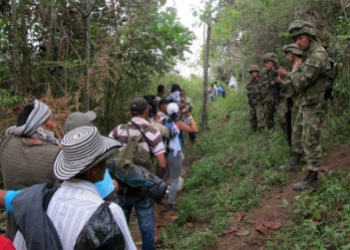A recent report has shown the scale to which forced displacements due to violence are increasing in Colombia, primarily affecting vulnerable groups like Afro-Colombians and indigenous communities.
Between January and October of this year, Colombia’s Ombudsman’s Office reported 58 instances of mass displacement, affecting a total of 15,140 people, according to the October 9 report.
The report found that the hardest hit area was the southern department of Nariño, where more than 5,400 people have been forced to abandon their homes. Following Nariño are the departments of Córdoba, Valle del Cauca, Norte de Santander, Chocó and Antioquia.
SEE ALSO: Colombia News and Profile
The document also points out two instances where communities were left completely cut off following recent outbreaks of violence in Putumayo and Antioquia.
The first occurred in July in Putumayo’s Puerto Asís municipality. Around 300 families were trapped as clashes broke out between dissident factions of the Revolutionary Armed Forces of Colombia (Fuerzas Armadas Revolucionarias de Colombia — FARC) and local criminal gangs.
The second case took place in August across four municipalities in Antioquia. More than 1,000 indigenous families were caught in the crossfire of intense fighting between the National Liberation Army (Ejército de Liberación Nacional — ELN) and Urabeños, leaving them without access to food or medical care.
InSight Crime Analysis
The Ombudsman’s Office stated that in most departments, a rise in forced displacement followed an escalation in violence between criminal groups for control of key illegal economies, such as drug trafficking, illegal mining and extortion.
Here, InSight Crime breaks down the situation on the ground in Colombia’s most affected departments.
Nariño
- 5,423 people displaced across 15 incidents
In Nariño, authorities have reported the presence of at least three ex-FARC mafia structures: the Oliver Sinisterra Front (Frente Oliver Sinisterra — FOS), the United Guerrillas of the Pacific (Guerrillas Unidas del Pacífico — GUP) and the Estiven González Front. The ELN, Urabeños and Contadores are also present in the department.
The most important dispute waged in this region is happening along the Pacific coast between the Contadores, FOS and GUP over control of illicit crops, processing laboratories and international drug trafficking routes.
SEE ALSO: Battles Between Former FARC Groups Displace Hundreds in Nariño
Nariño is the department with the largest coverage of coca crops, which makes it a strategic point for drug trafficking, according to the United Nations Office on Drugs and Crime (UNODC).
Antioquia and Córdoba
- 592 people displaced across 10 incidents in Antioquia
- 2,931 people displaced across nine incidents in Córdoba
Armed groups are contesting control of illegal gold mining as well as outgoing drug shipments in the south of Córdoba, adjacent to the Bajo Cauca region of Antioquia.
The Caparrapos, former allies turned bitter rivals of the Urabeños, are vying for control of municipalities with long mining traditions, such as Caucasia and El Bagre in Antioquia. Criminal groups in this part of the country can make up to $725,000 per month from illegal mining activities.
SEE ALSO: Illegal Mining Crackdown in Timbiquí, Colombia Angers Residents
FARC dissidents, such as the 18th Front under the control of Erlison Echavarría, alias “Ramiro,” and the 36th Front led by Ricardo Ayala, alias “Cabuyo,” are also present in this region. In addition to drug trafficking, these dissident blocks are financed by extorting public transport operators and merchants. The 18th Front is also responsible for several kidnappings in the department, according to El Colombiano.
There is currently an alliance between the Caparrapos, ELN and 18th Front to confront the Urabeños and manage drug trafficking coming out of the region.
Valle del Cauca
- 2,652 people displaced across two incidents
Ongoing mass displacements in Valle de Cauca are largely related to threats posed by the FARC dissidents’ “Jaime Martinez” column, which is led by Leider Johani Noscue, alias “Mayimbú.” The Popular Liberation Army (Ejército Popular de Liberación — EPL), Urabeños, ELN and, to a lesser extent, two other criminal groups known as “La Local” and “La Empresa” all operate here.
Buenaventura, Jamundí and Bolívar are the municipalities most affected due to the fight for control of drug trafficking in the Naya River corridor, which connects the country’s western and central mountain ranges to the Pacific Ocean.
FARC dissidents in Valle del Cauca also extort public transport workers and merchants for fees reaching thousands of dollars per month.
Norte de Santander
- 1,779 people displaced across six incidents
Clashes over the control of illicit coca crops, processing and trafficking persist in Norte de Santander, particularly in the northeast Catatumbo region.
After a bloody battle between the EPL and ELN in 2018, some of these confrontations have continued on a small scale in municipalities like Teorama, el Tarra, Hacarí, Playa de Belén and Sardinata.
Violence has escalated in Norte de Santander due to divisions within the EPL, primarily between a faction of the guerrilla in Catatumbo and another that is focused on drug trafficking, which has adopted a drug route on the border of the metropolitan area of the city of Cúcuta in alliance with the Rastrojos.

